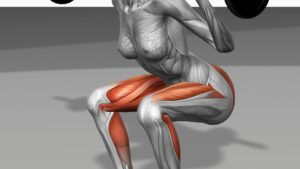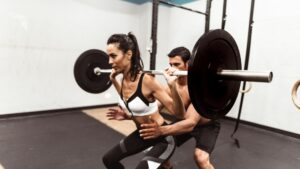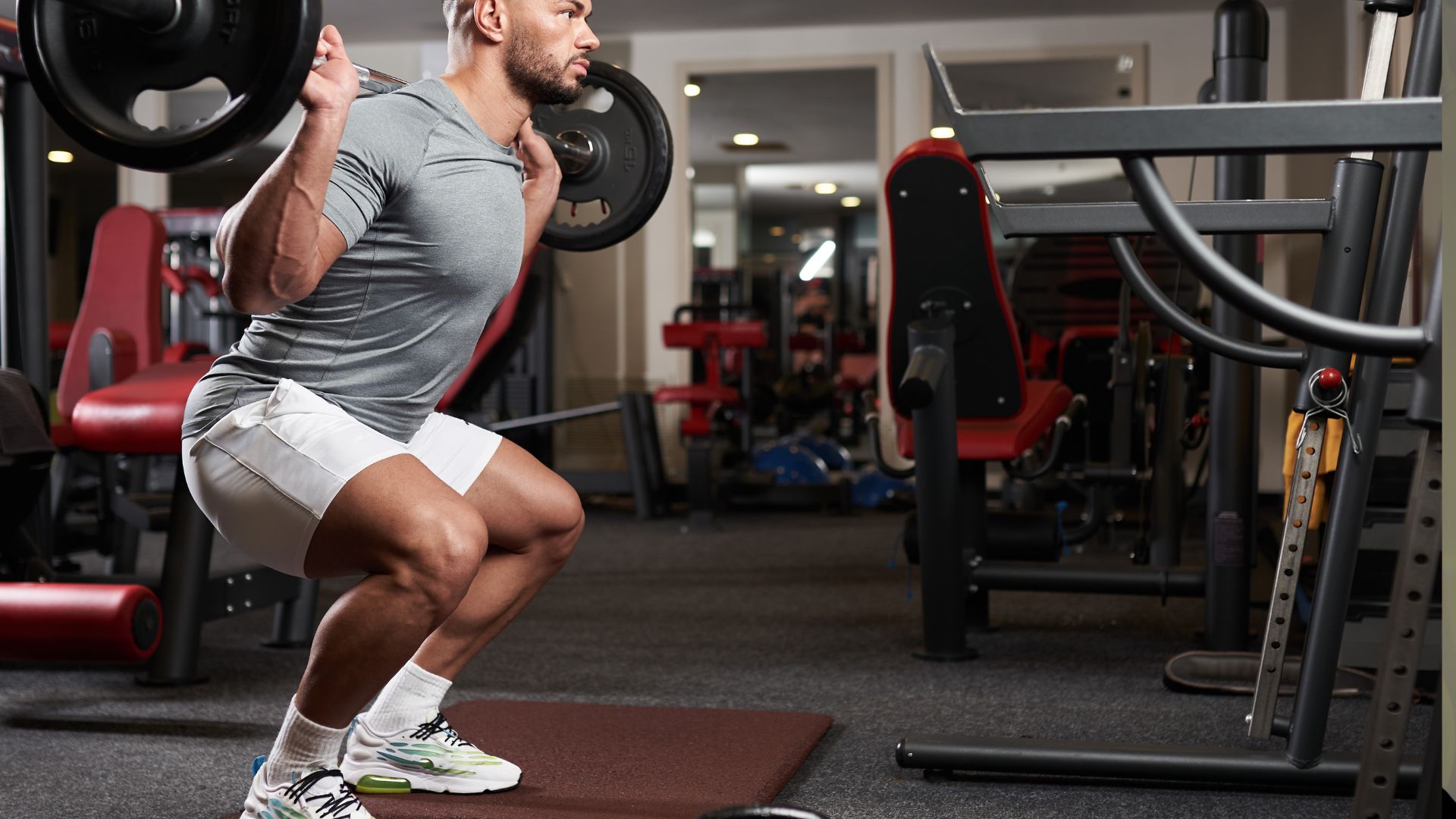Hey there, fitness enthusiasts! Are you on a quest for those killer glutes that you’ve been dreaming about? You know, the kind that make heads turn when you walk into a room? Well, you’re in the right place because today, we’re diving deep (pun intended) into the fascinating world of squat depths and how they can make or break your booty gains.
Picture this: You walk into the gym, eager to crush your leg day workout. You’ve heard about squats being the holy grail of lower body exercises, but you’re left wondering, “What’s the magic squat depth for sculpting those glutes of steel?” Don’t worry; we’ve got your back (and your glutes) covered.
Whether you’re a seasoned lifter or just starting your fitness journey, we’ll break down the different squat depths, from the classic parallel squat to the daring “ass-to-grass” version. We’ll dish out expert advice, tips, and all the juicy details you need to know to make an informed decision about which squat depth suits you best.
So, grab your workout gear, a water bottle, and your curiosity because it’s time to uncover the secrets to those head-turning glutes. Let’s get started on the road to glute greatness! 💪🍑
Understanding the best squat depth for glutes and why.
The ideal squat depth for targeting the glutes can vary depending on individual factors and goals. However, here’s some specific information to help you understand how squat depth affects glute engagement:
Parallel Squats (90-Degree Angle): Going down until your thighs are parallel to the ground (creating a 90-degree angle at your knees) is a good starting point.
This depth engages the glutes, quads, and hamstrings fairly evenly. It’s a balanced option if you want to work multiple lower body muscles.
Deep Squats (Below Parallel): Going below parallel, where your hips go below knee level, can increase glute activation.
This is often recommended for those specifically looking to target and build their glutes. However, it requires good form and mobility to avoid stressing the knees or lower back.
Ass-to-Grass Squats: This term refers to squatting until your glutes touch your heels or go as deep as your flexibility allows.
It maximizes glute engagement but also places more strain on the knees and lower back. It’s generally reserved for advanced lifters and those with excellent mobility.
Box Squats: Box squats involve squatting onto a box or bench, which can be adjusted to your desired depth.
This is a good way to control and gradually increase your squat depth while ensuring proper form. You can progressively lower the box as your flexibility and strength improve.
Split Squats and Lunges: These exercises can also be effective for targeting the glutes.
They require a different range of motion compared to traditional squats and can be a valuable addition to your lower body workout routine.
In other words, the best squat depth for targeting the glutes depends on your fitness level, mobility, and goals.
Starting with parallel squats and gradually progressing to deeper squats, if appropriate for your body, is a common approach.
It’s essential to prioritize proper form to prevent injury and maximize glute activation. Additionally, a well-rounded lower body workout that includes a variety of exercises can help you achieve balanced muscle development in your lower body.
Further Explanations.
Let’s delve deeper, let me explain these points mentioned further.
First, let’s dive deeper into the differences between parallel squats (90-degree angle) and deep squats (below parallel) in terms of glute engagement and the considerations for each:
Parallel Squats (90-Degree Angle).
Muscle Engagement:
When you perform parallel squats, you typically reach a depth where your thighs are parallel to the ground, forming a 90-degree angle at your knees. This position engages multiple lower body muscles fairly evenly.

Your glutes, quads (front thigh muscles), and hamstrings (back thigh muscles) all play significant roles in lifting the weight back up.
Balanced Workout:
Parallel squats are considered a balanced lower body exercise. They work not only your glutes but also your quads and hamstrings, providing a comprehensive lower body workout.
This makes them a suitable choice if you want to develop overall lower body strength and muscle.
Safety and Form:
Parallel squats are generally safer for beginners or those with limited mobility. Maintaining proper form is relatively easier, and there’s less risk of overloading the knees or lower back.
Deep Squats (Below Parallel).
Increased Glute Activation:
Going below parallel in squats involves lowering your hips below the level of your knees. This deeper squat engages the glutes to a greater extent.
The glutes are particularly activated when you push out of the deep squat position to return to a standing position.
Targeted Glute Development:
Deep squats are often recommended for individuals who specifically want to target and build their glutes. The deeper range of motion puts more emphasis on the glute muscles, helping with glute development and strengthening.
Form and Mobility:
Achieving and maintaining proper form during deep squats can be more challenging. It requires good hip and ankle mobility, as well as core stability.
If your mobility or form is lacking, there is a higher risk of placing undue stress on the knees or lower back.
In essence, the choice between parallel squats and deep squats depends on your fitness goals, mobility, and experience level.
Parallel squats provide a balanced lower body workout, engaging multiple muscle groups, while deep squats are more focused on targeting and building the glutes.
It’s crucial to prioritize good form and gradually progress to deeper squats if you choose to go below parallel, to minimize the risk of injury and ensure effective glute engagement. Consulting with a fitness professional can also help tailor your squat depth to your specific goals and abilities.
let’s delve into the details of “Ass-to-Grass Squats” and “Box Squats” to understand their benefits and considerations:
Ass-to-Grass Squats.
Depth of Movement:
Ass-to-Grass squats involve squatting until your glutes touch your heels or going as deep as your flexibility allows. This means your hips drop below knee level, achieving a full range of motion.

Glute Engagement:
These squats maximize glute engagement. The deep squat position places a significant emphasis on the glute muscles, making it an excellent choice for those looking to target and build their glutes.
Advanced Level:
Ass-to-Grass squats are generally reserved for advanced lifters with excellent mobility and squatting technique.
Achieving and maintaining proper form during these deep squats can be challenging, and there is a greater risk of injury if your mobility or form is lacking.
Considerations:
The deep squat position can place more strain on the knees and lower back compared to shallower squats.
Therefore, it’s crucial to have excellent mobility, strength, and core stability before attempting Ass-to-Grass squats. Proper warm-up and mobility exercises are also essential to prepare the body for this level of squat depth.
Box Squats.
Controlled Depth:
Box squats involve squatting onto a box or bench, which can be adjusted to your desired depth.
This allows you to control the depth of your squats and gradually progress as your flexibility and strength improve.
Form and Safety:
Box squats are an excellent tool for ensuring proper form during squats.
By setting the box at an appropriate height, you can practice squatting to a specific depth while maintaining good technique. This can help reduce the risk of injury and improve your squat mechanics.
Progression:
Box squats are particularly useful for beginners and those working on improving their squatting depth.
You can start with a higher box and progressively lower it as you become more comfortable with the movement and your mobility improves.
Muscle Engagement:
While box squats can engage the glutes, quads, and hamstrings, their primary benefit is in providing a controlled environment for squatting, which can be used to improve overall squat performance.
In all of this is that, Ass-to-Grass squats are advanced and focus on maximizing glute engagement but require excellent mobility and technique.
Box squats, on the other hand, are a tool for controlled squat depth and form improvement, making them suitable for individuals of various skill levels, including beginners.
Choosing between these two squat variations should depend on your current fitness level, goals, and the need for controlled progression and form correction.
Always prioritize safety and proper technique when performing squats of any kind.
Split Squats and Lunges
Let’s explore the benefits and considerations of split squats and lunges as effective exercises for targeting the glutes:
Split Squats:
Range of Motion:
Split squats involve standing with one foot forward and one foot back, creating a split stance. You then lower your body by bending both knees until the back knee hovers just above the ground or touches lightly.
This exercise provides a different range of motion compared to traditional squats.
Glute Engagement:
Split squats effectively target the glute muscles, especially the gluteus maximus. The forward-leaning position and deep knee flexion engage the glutes throughout the movement.
Balance and Stability:
Split squats require balance and stability because you’re supporting your body on one leg. This can help improve overall lower body stability and enhance coordination.
Variation:
You can perform split squats with body weight or add resistance by holding dumbbells or using a barbell. This allows for progression and customization based on your fitness level and goals.
Lunges:
Range of Motion:
Lunges involve taking a step forward or backward and then lowering your body by bending both knees until they form 90-degree angles.
Like split squats, lunges provide a different range of motion compared to traditional squats.
Glute Engagement:
Lunges also engage the glutes effectively, especially when performed with proper form. The lunge motion requires hip extension and flexion, activating the glute muscles throughout the movement.
Balance and Coordination:
Lunges, like split squats, require balance and coordination because you’re moving one leg at a time. This can improve your proprioception and overall lower body stability.
Variation:
Similar to split squats, lunges can be modified to match your fitness level and goals. You can perform bodyweight lunges, walking lunges, or add resistance to increase the challenge.
In other words, both split squats and lunges are excellent exercises for targeting the glutes while providing a different range of motion compared to traditional squats.
They can be valuable additions to your lower body workout routine, offering variety and helping to prevent exercise plateaus.
Incorporating these exercises into your training regimen can contribute to well-rounded glute development and lower body strength.
As with any exercise, it’s essential to maintain proper form and gradually increase intensity to avoid injury and achieve the best results.
A tabular on this topic here.
Determining the “best” squat depth for targeting the glutes can vary from person to person based on individual factors, goals, and preferences.
Here’s a tabular comparison of different squat depths, their impact on glute engagement, and considerations:
| Squat Depth | Glute Engagement | Considerations |
|---|---|---|
| Parallel Squats (90°) | Moderate to High | Engages glutes, quads, and hamstrings. |
| Deep Squats (<90°) | High | Focuses on glutes; requires good form and mobility. |
| Ass-to-Grass Squats | Very High | Maximizes glute activation; advanced level, high mobility required. |
| Box Squats | Variable (adjustable) | Allows controlled progression and form improvement. |
| Split Squats | High | Targets glutes, improves balance and stability. |
| Lunges | High | Engages glutes, improves balance and coordination. |
Please note that the “Glute Engagement” column provides a general ranking from moderate to very high, but individual experiences may vary. The “Considerations” column highlights important factors to keep in mind when choosing a squat depth. It’s essential to select a depth that aligns with your fitness level, mobility, and specific training goals while prioritizing proper form to maximize glute activation and minimize the risk of injury.
Conclusion.
In conclusion, the “best” squat depth for targeting the glutes varies based on individual factors and goals.
Deep squats, ass-to-grass squats, split squats, and lunges engage the glutes effectively. Parallel squats offer a balanced lower body workout. Box squats provide controlled progression.
The choice should align with your fitness level, mobility, and objectives while emphasizing proper form for optimal glute activation and safety.

Hey there, it’s Mike Rrsq, the Editor-in-Chief over at Jsquat.com, and I’m absolutely obsessed with all things squat fitness! I’ve been lucky enough to get some serious recognition for my work in this field. With a solid background in the fitness and wellness industry, I’ve been there right from the get-go, helping shape this website into what it is today.
You see, I’m not just the boss around here; I’m also a passionate contributor. I love sharing my insights through my articles, and trust me, they’re not your run-of-the-mill stuff. Each piece I write is a labor of love, filled with my expertise and real-world experience in the fitness universe. So, if you’re into fitness and looking for some inspiration, you’re in the right place!

